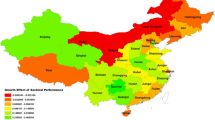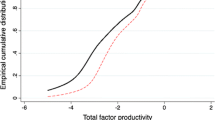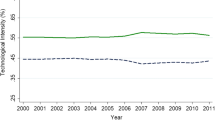Abstract
This paper uses a dynamic panel approach to investigate the impact of economic policy on industrial specialization and regional concentration of China’s high-tech industries for the period 1996–2005. It is found that the degrees of specialization and concentration show increasing trends throughout the sample period, while high-tech industry sector has increasingly concentrated in costal regions. It is also found that the implementation of high-technology-oriented export policy and subsidy for science and high-technology activities encourage specialization and concentration, whereas local governments’ protection for local high-tech enterprises results in convergence in regional industrial structure and obstructs regional concentration of high-tech industries. The estimation result is robust not only to the use of various estimation techniques, but also to the control for other factors proposed by theories such as transport costs and knowledge resources. Our findings support the idea that economic policies might play an important role in determining the geographic distribution of high-tech industries in China.
Similar content being viewed by others
Notes
Specialization and concentration reflects the characteristic of a region and an industry, respectively. See Aiginger and Davies (2004) for a thorough analysis on the differences and relations between the two terms.
The definition is compatible with OECD’s classification of high-technology industries, which take the share of R&D expenditure in manufacturing output or value added (i.e., R&D intensity) as criteria for classification.
Similar division has been used in Guo (1999) and Gao (2004). Northern Coast includes 5 provinces, which are Beijing, Tianjing, Hebei, Liaoninig and Shandong; Middle Coast includes 3 provinces, which are Shanghai, Jiangsu and Zhejiang; Southern Coast includes 4 provinces, which are Fujian, Guangdong, Guangxi and Hainan; Northern Inland includes 5 provinces, which are Shanxi, Inner Mongolia, Jilin, Heilongjiang and Shanxi; Middle Inland includes 5 provinces, which are Anhui, Henan, Hubei, Jiangxi and Hunan; Southern Inland includes 4 provinces, which are Chongqing, Sichuan, Guizhou and Yunnan; Far West Inland includes 4 provinces, which are Gansu, Qinghai, Ningxia and Xinjiang. Tibet is not included due to the incomplete data collection.
References
Aiginger K, Davies S (2004) Industrial specialization and geographic concentration: two sides of the same coin? Not for the European Union. J Appl Econ 2:231–248
Amiti M (1999) Specialization patterns in Europe. Rev World Econ (Weltwirtsch Arch) 135:573–593
Arellano M, Bond S (1991) Some tests of specification for panel data: Monte Carlo evidence and an application to employment equations. Rev Econ Stud 58:277–297
Arellano M, Bover O (1995) Another look at the instrumental variables estimation of error-components models. J Econ 68:29–51
Bai C, Du Y, Tao Z, Tong S (2004) Local protectionism and regional specialization: evidence from China’s industries. J Int Econ 63:397–417
Baldwin R, Rorslid R, Martin P, Ottaviano G, Robert-Nicoud F (2003) Economic geography and public policy. Princeton University Press, New Jersey
Blundell R, Bond S (2000) GMM estimation with persistent panel data: an application to production functions. Econ Rev 19:321–340
Bond S (2002) Dynamic panel data models: a guide to micro data methods and practice. Port Econ J 1:141–162
Brülhart M, Torstensson J (1996) Regional integration, scale economies and industry location in the European Union. CEPR Discussion paper no. 1435
Catin M, Luo X, Van Huffel C (2005) Openness, industrialization, and geographic concentration of activities in China. World Bank Policy Research Working Paper 3706
Devereux MP, Griffith R, Simpson H (2007) Firm location decisions, regional grants and agglomeration externalities. J Public Econ 91:413–435
Forslid R, Midelfart KH (2005) Internationalisation, industrial policy and clusters. J Int Econ 66:197–213
Gao T (2004) Regional industrial growth: evidence from Chinese industries. Reg Sci Urban Econ 34: 101–124
Ge Y (2009) Globalization and industry agglomeration in China. World Dev 37:550–559
Golley J (2002) Regional patterns of industrial development during China’s economic transition. Econ Trans 10:761–801
Guo R (1999) How the Chinese economy works: a multiregional overview. St. Martin’s Press, Cambridge
Head CK, Ries JC, Swenson DL (1999) Attracting foreign manufacturing: investment promotion and agglomeration. Reg Sci Urban Econ 29:197–218
Holmes TJ (1998) The effect of state policies on the location of manufacturing: evidence from state borders. J Polit Econ 106:667–705
Kim S (1995) Expansion of markets and the geographic distribution of economic activities: the trends in U.S. regional manufacturing structure, 1860–1987. Q J Econ 110:881–908
Krugman P (1991) Geography and trade. MIT Press, Boston
Li J, Qiu L, Sun Q (2003) Interregional protection: implications of fiscal decentralization and trade liberalization. China Econ Rev 14:227–245
Lu J, Tao Z (2009) Trends and determinants of China’s industrial agglomeration. J Urban Econ 65:167–180
Midelfart-Knarvik KH, Overman H, Redding S, Venables A (2000) The location of European industry, European Commission. Working paper 142, DG ECFIN
National Bureau of Statistics of China (1997–2006) China statistical yearbook. China Statistic Press, Beijing
National Bureau of Statistics of China (2002) Catalog for high-technology industrial statistics classification. China Statistic Press, Beijing
National Bureau of Statistics of China (2002, 2003 and 2008) China statistics yearbook on high technology industry. China Statistic Press, Beijing
Naughton B (2003) How much can regional integration do to unify China’s markets. In: Hope N, Yang D, Li M (eds) How far across the river? Chinese policy reform at the millennium. Stanford University Press, Palo Alto, pp 204–232
Ohlin B (1935) Interregional and international trade. Harvard University Press, Cambridge
Poncet S (2003) Measuring Chinese domestic and international integration. China Econ Rev 14:1–23
Roodman D (2009) How to do xtabond2: an introduction to difference and system GMM in Stata. Stata J 9:86–136
Wen M (2004) Relocation and agglomeration of Chinese industry. J Dev Econ 73:329–347
Young A (2000) The razor’s edge: distortions and incremental reform in the People’s Republic of China. Q J Econ 115:1091–1135
Zhao S, Zhong J (2008) Cluster momentum of high-tech industrial base-Guangdong as an example. In: Zhang H, Zhao R, Xie Z (eds) Industry cluster and meta-studies: proceedings of international conference on industry cluster development and management. Orient Academic Forum, Marrickville, pp 179–183
Zheng Y (2007) Explaining the sources of de facto federalism in reform China: intergovernmental decentralization, globalization, and central-local relations. Jpn J Polit Sci 7:101–126
Acknowledgments
Zheng acknowledges financial support from China Scholarship Council (CSC) via a scholarship under the State Scholarship Fund. Kuroda appreciates the financial support by JSPS: Grant-in-Aid for Scientific Research (B) 19330048. We thank Asao Ando, Domingo P. Ximénez-de-Embún, participants to the 24th Applied Regional Science Conference (Nagoya), the 51th European Regional Science Conference (Barcelona), and an anonymous referee for their helpful comments on an earlier version of this paper.
Author information
Authors and Affiliations
Corresponding author
Appendix
Appendix
To investigate the stationary properties of each time series, we first perform two standard unit root tests and report the results in Table 9. The result indicates that for all lagged variables, the unit root tests reject the null hypothesis that series has a unit root. Table 10 reports the estimation results of the simple AR(1) specifications for each time series. It is found that all series but local profit ratio has a positive and significant coefficient higher than 0.900, which provides strong evidence supporting the high persistence of each series.
Rights and permissions
About this article
Cite this article
Zheng, D., Kuroda, T. The impact of economic policy on industrial specialization and regional concentration of China’s high-tech industries. Ann Reg Sci 50, 771–790 (2013). https://doi.org/10.1007/s00168-012-0522-4
Received:
Accepted:
Published:
Issue Date:
DOI: https://doi.org/10.1007/s00168-012-0522-4




